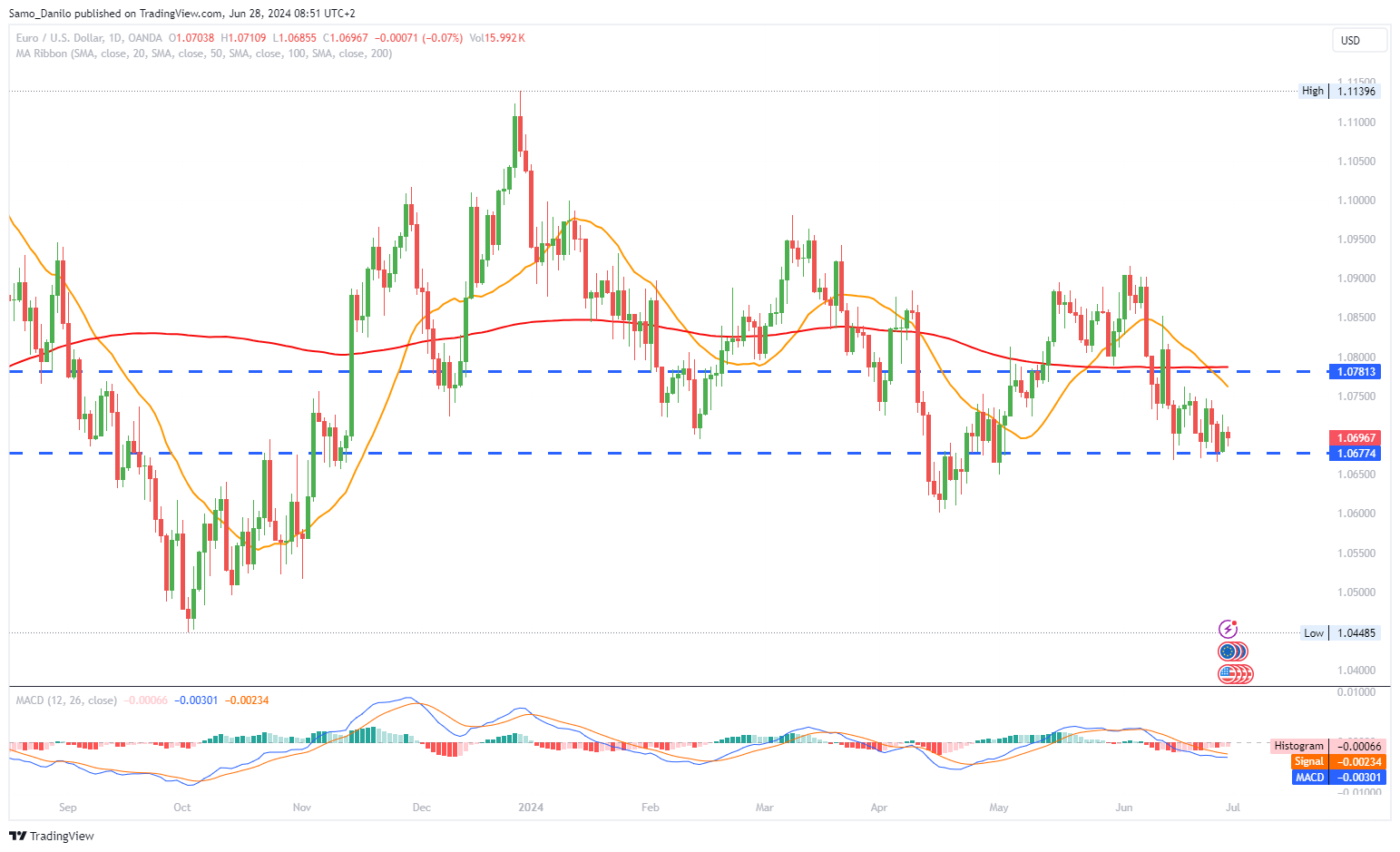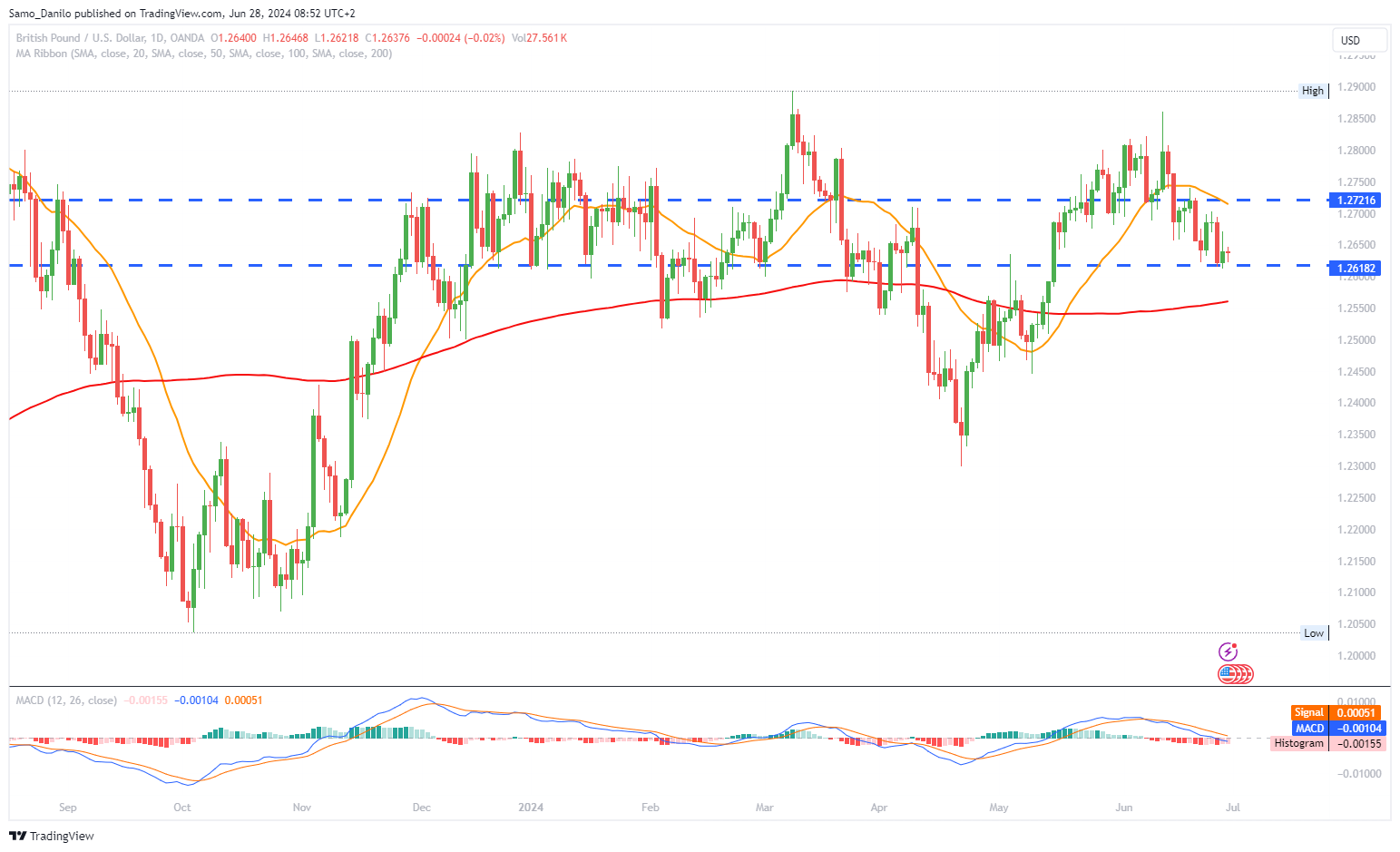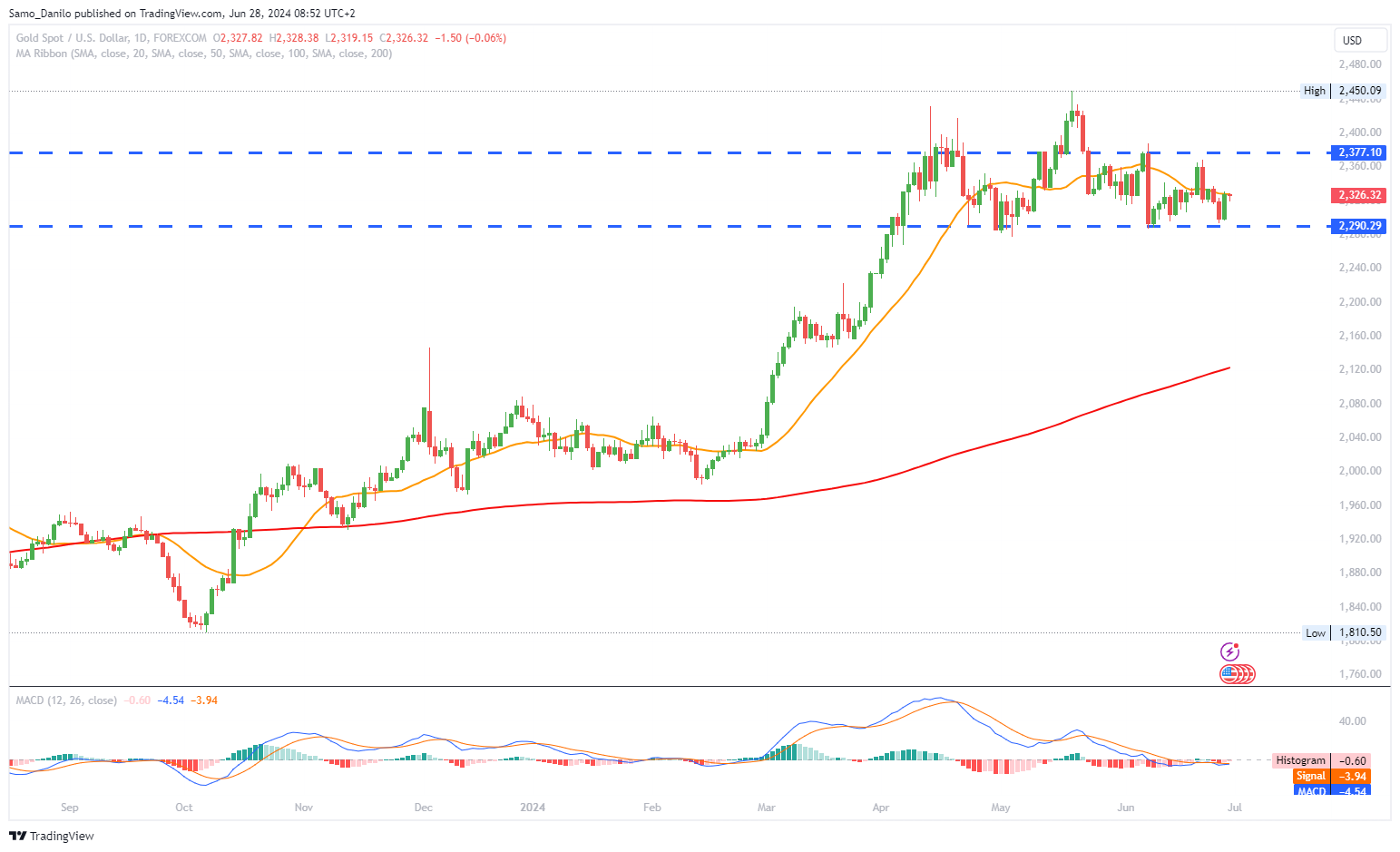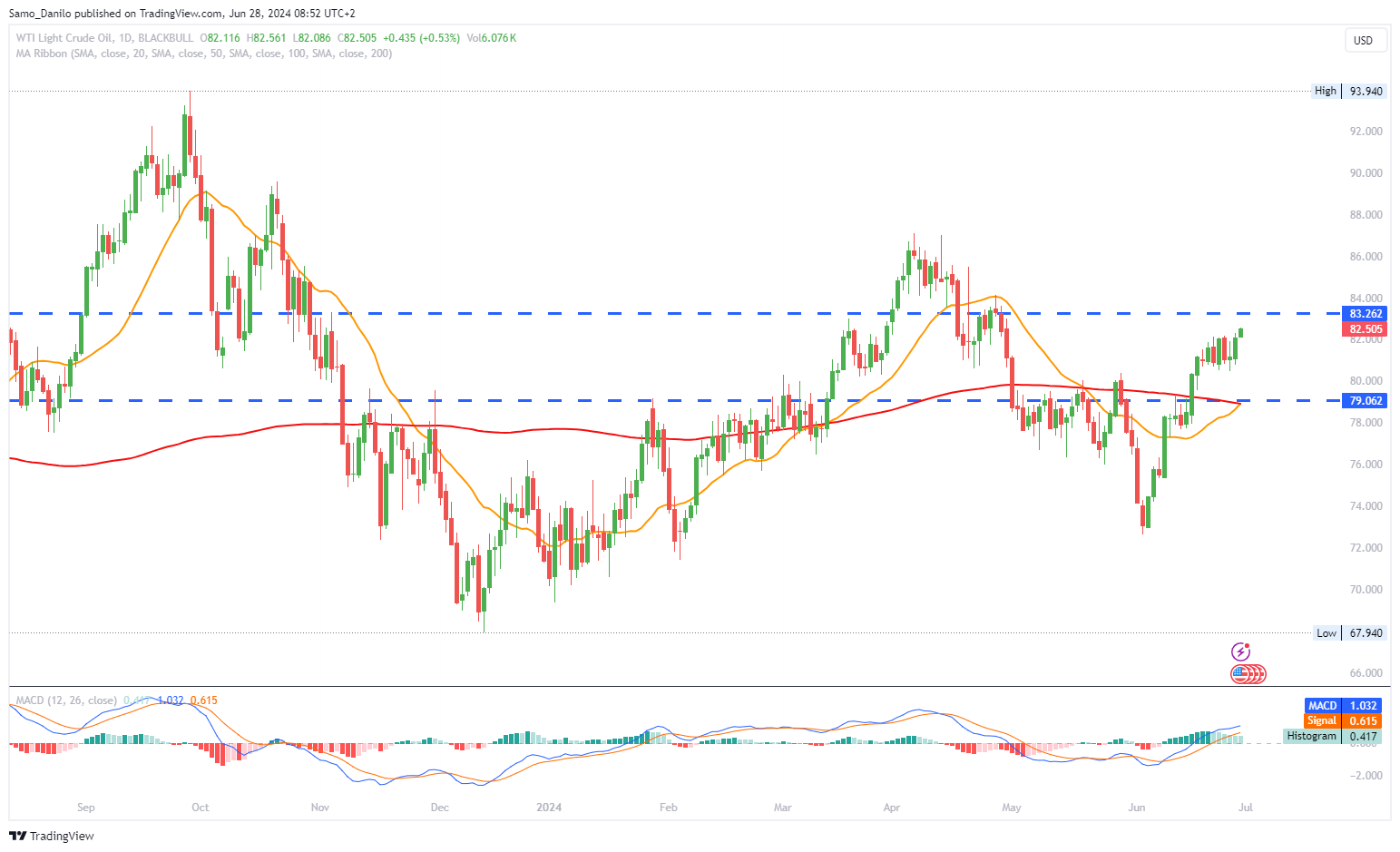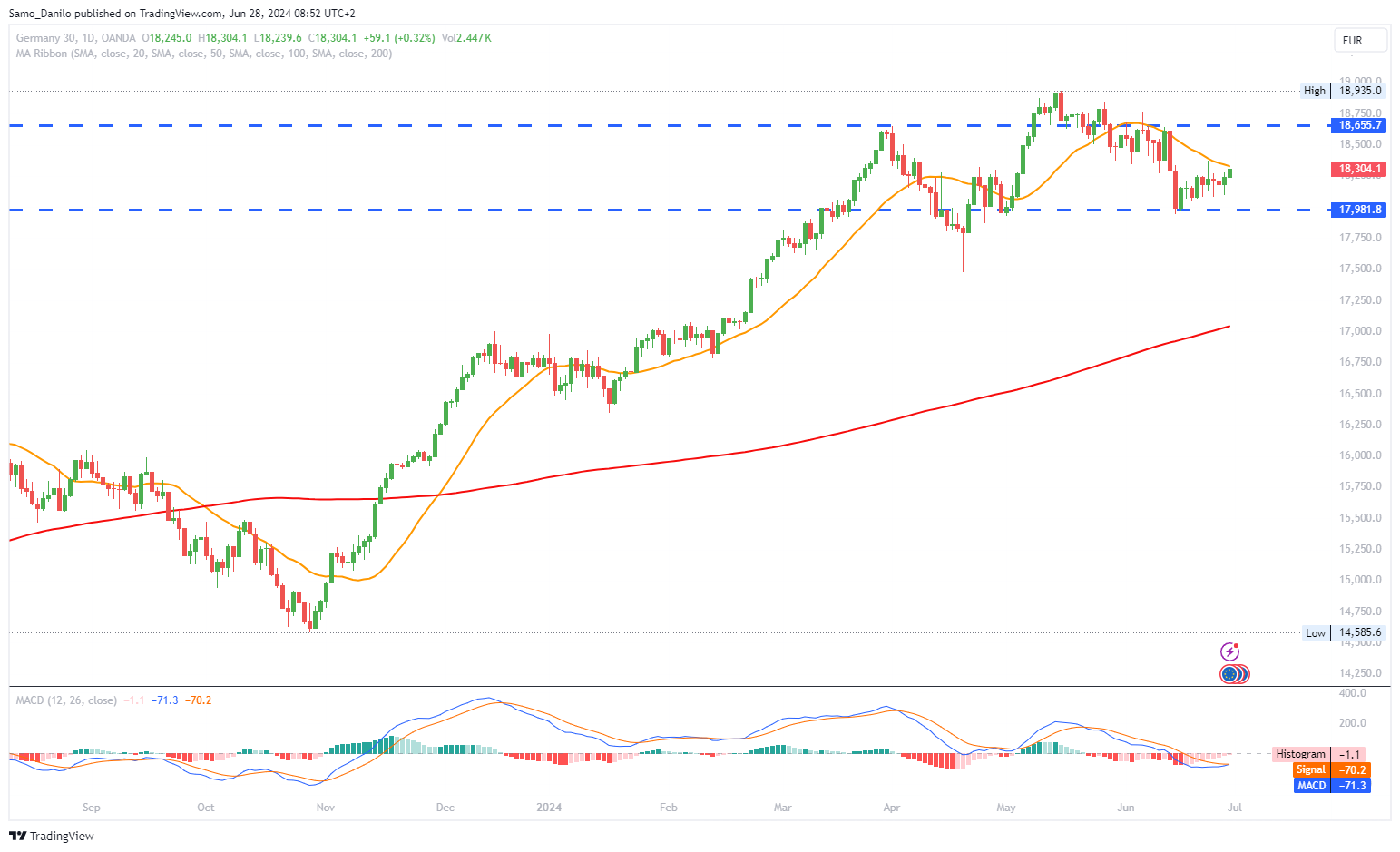EURUSD
- Trading Below 1.0700: The EUR/USD is back in the red, trading below 1.0700 in the early European morning on Friday.
- Steady Macroeconomic Situation: The macroeconomic situation on both sides of the Atlantic remains steady, with the European Central Bank (ECB) contemplating further rate cuts beyond summer. Market expectations suggest two more ECB rate cuts later in the year.
- ECB Rate Cut Speculation: ECB’s Peter Kazimir indicated the bank might consider another interest rate cut later this year after the reduction implemented this month, although not during the summer.
- Fed Rate Cut Debate: Market participants continue to debate whether the Federal Reserve (Fed) will implement one or two rate cuts this year, despite the Fed forecasting just one cut, likely in December.
- Widened Policy Gap: In the short term, the recent ECB rate cut, compared to the Fed's decision to maintain rates, has widened the policy gap between the two central banks. This could lead to further weakness in the EUR/USD.
Closing statement: The EUR/USD faces downward pressure as the policy divergence between the ECB and the Fed widens. While the ECB is contemplating further rate cuts, the Fed's more cautious stance on rate reductions could lead to continued weakness in the EUR/USD. Investors will closely monitor upcoming economic data and central bank communications for further direction.
GBPUSD
- Trading Below 1.2650: GBP/USD stays on the back foot, trading below 1.2650 in European trading on Friday.
- Technical Correction: The pair staged a technical correction toward 1.2650 in the European morning on Thursday. However, the technical outlook does not offer any convincing signs pointing to an extended rebound.
- UK Q1 Final GDP: The UK Q1 final GDP came in at +0.7% vs. +0.6% q/q preliminary estimate, showing a slight improvement.
- US Initial Jobless Claims: The US Department of Labor will release the weekly Initial Jobless Claims data, forecasted to come in at 236,000 for the week ending June 22.
- Upcoming PCE Price Index: On Friday, the Bureau of Economic Analysis (BEA) will publish the Personal Consumption Expenditures (PCE) Price Index for May, the Federal Reserve's preferred gauge of inflation.
| SMA (20) | Slightly Falling |
| |
| RSI (14) | Slightly Falling |
| |
| MACD (12, 26, 9) | Falling |
|
|
Closing statement: The GBP/USD pair remains under pressure, struggling to hold above 1.2650. While the UK GDP data provided a slight boost, the technical outlook remains unconvincing for a sustained rebound. Market participants will closely watch the upcoming US Initial Jobless Claims and PCE Price Index data for further clues on the economic outlook and potential impacts on the GBP/USD pair.
GOLD
- Gold Price Movement: The gold price snapped its rebound from two-week lows early Friday, losing ground after encountering resistance near the $2,330 level.
- US Economic Data: On Thursday, mixed US growth, Durable Goods Orders, and housing data exerted downward pressure on the US Dollar, influencing gold prices.
- US Presidential Election Debate: The first US presidential election debate leading up to the November 5 polls had little to no impact on the value of the US Dollar and gold prices.
- Key Data Focus - PCE Inflation: The next direction for gold prices remains in the hands of the US Personal Consumption Expenditure (PCE) inflation data.
- PCE Price Index Expectations: The US annual PCE Price Index is projected to rise 2.6% in May, compared to a 2.7% increase in April. The Federal Reserve's preferred inflation measure, the core PCE figure, is expected to accelerate by 2.6% YoY, slowing from a 2.8% growth in April.
| SMA (20) | Slightly Falling |
|
| RSI (14) | Slightly Falling |
|
| MACD (12, 26, 9) | Slightly Falling |
|
Closing statement: Gold prices are currently struggling to maintain their rebound, with the $2,330 resistance proving challenging. Mixed US economic data and anticipation of the upcoming PCE inflation data are significant factors influencing gold's near-term direction. Market participants will closely monitor the PCE figures to gauge the Federal Reserve's potential monetary policy actions, which will likely have a substantial impact on gold prices.
CRUDE OIL
- Current Price Movement: West Texas Intermediate (WTI) crude oil price extends gains for the third consecutive session, trading near $82.20 during the Asian session on Friday.
- Weekly Performance: Crude oil prices are set to advance for the third straight week, primarily due to supply threats stemming from escalating conflicts in the Middle East.
- Geopolitical Tensions: On Thursday, the French foreign ministry expressed concern over the situation in Lebanon. Additionally, Turkey declared its solidarity with Lebanon and called for support from regional governments, contributing to supply fears.
- Weather-Related Supply Disruptions: According to FGE Energy, oil supplies have been pressured by weather-related disruptions, which could worsen in the coming weeks. Heavy rains in Ecuador have caused production to decline by 100,000 barrels a day over the past week.
- Hurricane Threat: The US National Hurricane Center is currently tracking at least one weather system with the potential to develop into a cyclone and head toward the US Gulf Coast. This could negatively impact a significant portion of the country's energy and export infrastructure.
| SMA (20) | Slightly Rising |
| |
| RSI (14) | Rising |
|
|
| MACD (12, 26, 9) | Rising |
|
|
Closing statement: WTI crude oil prices continue to rise, bolstered by supply threats related to geopolitical tensions in the Middle East and weather-related disruptions. The ongoing conflict and potential for further supply interruptions, combined with the threat of a hurricane impacting the US Gulf Coast, are key factors driving the current price rally. Market participants will closely monitor these developments to assess their impact on oil prices in the near term.
DAX
- French Elections and EU Stability: Debates about a potential far-right win in the upcoming French elections continued on Thursday, causing investor jitters about a National Rally party victory to intensify.
- US Economic Indicators and Fed Rate Cut Bets: Investors increased their bets on a September Fed rate cut following finalized numbers showing the US economy slowed significantly from 3.4% to 1.4% in Q1 2024.
- EU Tariffs on Chinese EV Imports: Reports of the EU adjusting its tariffs on electric vehicle imports from China raised hopes of progress to avert an all-out trade war. However, the minor adjustments limited the impact on auto stocks.
- Upcoming German Unemployment Figures: On Friday, German unemployment figures could influence investor expectations of a Q3 2024 ECB rate cut. Economists forecast a slight increase in unemployment from 2.762 million to 2.770 million in June.
- French Inflation Data: Preliminary French inflation numbers for June are also significant, as higher-than-expected inflation could derail ECB rate cut plans.
| SMA (20) | Slightly Falling |
| |
| RSI (14) | Slightly Rising |
| |
| MACD (12, 26, 9) | Falling |
|
|
Closing statement: The DAX faces multiple influencing factors, including political uncertainty from the French elections, economic data from the US, and EU trade policies. Additionally, upcoming German unemployment figures and French inflation data will be crucial in shaping investor expectations regarding potential ECB rate cuts. Market participants will need to closely monitor these developments to navigate the current economic landscape.
